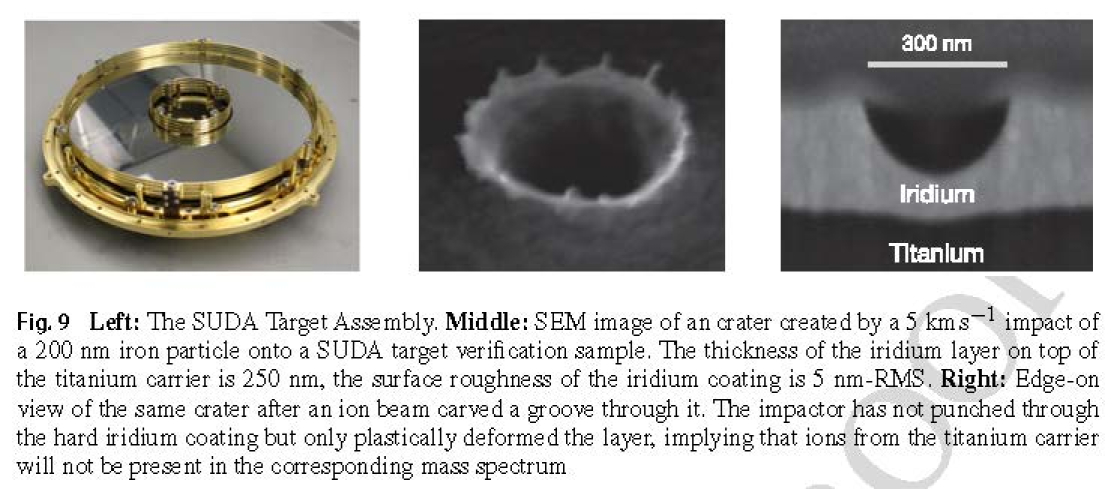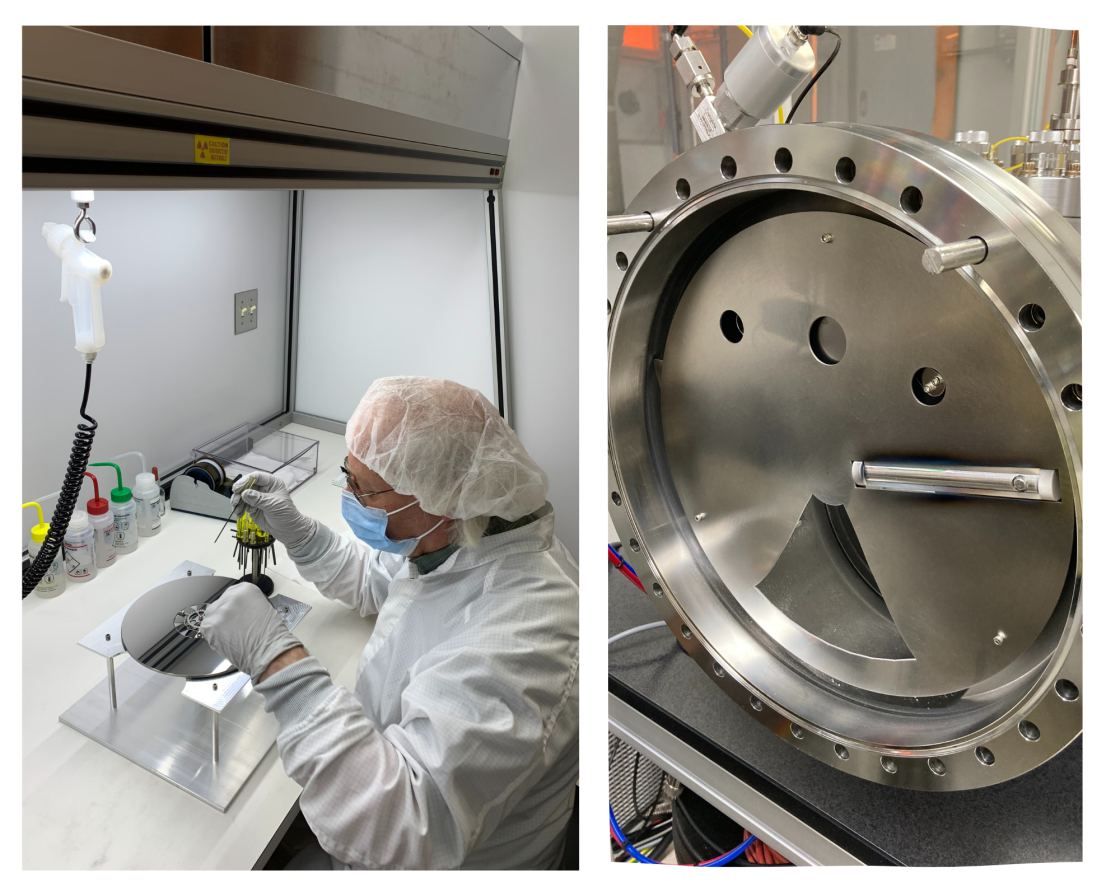With the recent launch of NASA's Europa Clipper, science takes a bold step closer to answering one of its most profound questions: could the building blocks for life exist beyond Earth? Aboard the spacecraft is the Surface Dust Analyzer (SUDA), a cutting-edge instrument designed to analyze tiny particles ejected from Europa's icy surface. These particles could provide crucial insights into the moon's hidden ocean and its potential to support life.
At the heart of this revolutionary instrument lies a critical component developed by LASP (the Laboratory for Atmospheric and Space Physics) with assistance from JILA’s W.M. Keck Lab: an iridium-coated titanium target that makes the high-precision analysis of cosmic dust possible. While LASP designed and built the instrument, their collaboration with JILA highlights the abilities of the University of Colorado Boulder’s institutes to tackle complex scientific and engineering challenges, advancing our understanding of the solar system and pushing the boundaries of exploration.
“JILA’s technical contribution to SUDA, the ultra-pure and optical quality iridium coating of the impact target, is a critical component to the instrument,” said SUDA Project Manager Scott Tucker, who also serves as LASP’s Engineering Director. “Thanks to this collaboration, we’ve created an instrument that will help scientists address fundamental questions for humanity, including whether other bodies in our solar system possess the chemical building blocks for life.”
A Collaboration Between LASP and JILA
SUDA is a time-of-flight impact ionization mass spectrometer to analyze the composition of dust and ice particles ejected from Europa's surface, determining what molecules the dust is made of. A key component of SUDA is the iridium-coated titanium target, which enables accurate mass spectrometry by ensuring chemical stability and ionization efficiency upon particle impact.
This unique challenge brought LASP to JILA’s W.M. Keck Lab in 2015.
Since its inception in 1962 as a joint institute between NIST (the National Institute of Standards and Technology) and CU Boulder, JILA’s technical expertise has been instrumental in refining technical processes like those required for SUDA's operational success.
“An engineer from LASP approached us because their vendor was struggling to polish titanium plates for SUDA. Polishing titanium is notoriously difficult, but we had prior success with similar materials,” says David Alchenberger, a former director of JILA’s Keck Lab and the lead in the coating task for the project.
How to Get an Inert Material to Stick Evenly
After contributing suggestions to the polishing challenges, Alchenberger and his assistant, Mark Carter, shifted to coating the titanium substrates with iridium to obtain the target characteristics needed.
“Iridium is incredibly inert, which makes it ideal for resisting space radiation,” Alchenberger adds. “But that same inertness made it extremely difficult to adhere to titanium. We had to innovate, combining high-temperature treatments with an argon bombardment process to prepare the surface and create bonds between the materials.”
While that encouraged the iridium to adhere to the target’s surface, the layer of iridium wasn’t perfectly uniform, causing inaccuracies in the dust detection process.
To overcome this issue, Alchenberger and Carter devised a custom-designed tool: a deposition mask to ensure that the iridium layer would be applied uniformly across the titanium surface, compensating for variations in coating thickness caused by the rotation of the substrate during the sputtering process.
“The mask was like a stencil, carefully calculated to account for the unique motion and deposition characteristics required,” Alchenberger explains.
This precision design not only improved adhesion but also minimized waste of the rare and expensive iridium, ultimately delivering the high-quality, reliable coating essential for SUDA’s mission success. After creating the target prototype, Alchenberger and Carter got approval from NASA and LASP to make the final products that would be used in the SUDA instrument.
Curtis Beimborn, Alchenberger’s successor as the Keck Lab director, continued the project during the final phases after Alchenberger retired in 2020.
“We had to heat the titanium to 400 degrees Celsius and maintain that temperature for hours before even beginning the coating process,” Beimborn elaborates.
He further highlighted the collaboration and resourcefulness that defined the Keck Lab’s approach.
“JILA's culture of out-of-the-box thinking allowed us to come up with creative solutions, like sourcing alternative heater bulbs when the original components repeatedly failed during production,” Beimborn notes.
Celebrating Success
After years of development, the final iridium-coated targets passed NASA's rigorous testing protocols, including adhesion and thermocycling trials. Alchenberger, Carter, and Beimborn attended a send-off ceremony hosted by LASP, where SUDA’s contributors were honored.
“It was gratifying to see the project come together,” says Alchenberger. “Knowing that something we worked on will play a role in searching for conditions that could support life on Europa is incredible.”
Reflecting on JILA's contributions, Beimborn adds, “Particles from the surface of a far away moon will touch a JILA-made component. That’s an extraordinary legacy for our lab.”
Continuing Impact
JILA’s success with SUDA has cemented its reputation as a trusted partner for NASA and LASP. The lab’s involvement in subsequent projects, including the IDEX instrument for NASA’s upcoming IMAP mission and the AETHER instrument for NASA’s GDC mission, underscores its ongoing contributions to space exploration.
“These collaborations illustrate JILA’s unique ability to merge technical ingenuity with scientific discovery,” Beimborn states.
Written by Kenna Hughes-Castleberry, JILA Senior Science Communicator
More About Europa Clipper
Europa Clipper’s three main science objectives are to determine the thickness of the moon’s icy shell and its interactions with the ocean below, to investigate its composition, and to characterize its geology. The mission’s detailed exploration of Europa will help scientists better understand the astrobiological potential for habitable worlds beyond our planet.
Managed by Caltech in Pasadena, California, JPL leads the development of the Europa Clipper mission in partnership with the Johns Hopkins Applied Physics Laboratory in Laurel, Maryland, for NASA’s Science Mission Directorate in Washington. APL designed the main spacecraft body in collaboration with JPL and NASA’s Goddard Space Flight Center in Greenbelt, Maryland, NASA’s Marshall Space Flight Center in Huntsville, Alabama, and Langley Research Center in Hampton, Virginia. The Planetary Missions Program Office at Marshall executes program management of the Europa Clipper mission. NASA’s Launch Services Program, based at Kennedy, managed the launch service for the Europa Clipper spacecraft.
Find more information about Europa Clipper here:




 The Physics Frontiers Centers (PFC) program supports university-based centers and institutes where the collective efforts of a larger group of individuals can enable transformational advances in the most promising research areas. The program is designed to foster major breakthroughs at the intellectual frontiers of physics by providing needed resources such as combinations of talents, skills, disciplines, and/or specialized infrastructure, not usually available to individual investigators or small groups, in an environment in which the collective efforts of the larger group can be shown to be seminal to promoting significant progress in the science and the education of students. PFCs also include creative, substantive activities aimed at enhancing education, broadening participation of traditionally underrepresented groups, and outreach to the scientific community and general public.
The Physics Frontiers Centers (PFC) program supports university-based centers and institutes where the collective efforts of a larger group of individuals can enable transformational advances in the most promising research areas. The program is designed to foster major breakthroughs at the intellectual frontiers of physics by providing needed resources such as combinations of talents, skills, disciplines, and/or specialized infrastructure, not usually available to individual investigators or small groups, in an environment in which the collective efforts of the larger group can be shown to be seminal to promoting significant progress in the science and the education of students. PFCs also include creative, substantive activities aimed at enhancing education, broadening participation of traditionally underrepresented groups, and outreach to the scientific community and general public.